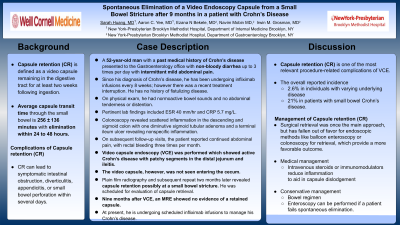Monday Poster Session
Category: IBD
P2260 - Spontaneous Elimination of a Video Endoscopy Capsule from a Small Bowel Stricture After 9 Months in a Patient with Crohn’s Disease
Monday, October 23, 2023
10:30 AM - 4:15 PM PT
Location: Exhibit Hall

Has Audio
.jpg)
Sarah Huang, MD
New York Presbyterian Brooklyn Methodist Hospital
Brooklyn, New York
Presenting Author(s)
Sarah Huang, MD1, Aaron Yee, MD2, Ezana Bekele, MD3, Navim Mobin, MD1, Irvin Grosman, MD3
1New York Presbyterian Brooklyn Methodist Hospital, Brooklyn, NY; 2NYP Brooklyn Methodist Hospital, Brooklyn, NY; 3New York Presbyterian Brooklyn Methodist, Brooklyn, NY
Introduction: Capsule retention (CR) is defined as a video capsule remaining in the digestive tract for at least two weeks following ingestion. On average, capsule transit time through the small bowel is 256 ± 136 minutes with elimination within 24 to 48 hours. CR can lead to symptomatic intestinal obstruction, diverticulitis, appendicitis, or small bowel perforation within several days, and may require endoscopic removal or surgical management.
Case Description/Methods: A 52-year-old man with a past medical history of Crohn’s disease presented to the Gastroenterology office with non-bloody diarrhea up to 3 times per day with intermittent mild abdominal pain. Since his diagnosis of Crohn’s disease, he has been undergoing infliximab infusions every 8 weeks; however there was a recent treatment interruption. He has no history of fistulizing disease. His physical exam was benign, with normoactive bowel sounds and no abdominal tenderness or distention. Pertinent lab findings included ESR 40 mm/hr and CRP 5.7 mg/L. Colonoscopy revealed scattered inflammation in the descending and sigmoid colon with one diminutive sigmoid tubular adenoma and a terminal ileum ulcer revealing nonspecific inflammation. On subsequent follow-up visits, the patient reported continued abdominal pain, with rectal bleeding three times per month. Video capsule endoscopy (VCE) was performed which showed active Crohn’s disease with patchy segments in the distal jejunum and ileitis. The video capsule, however, was not seen entering the cecum. Plain film radiography and subsequent repeat two months later revealed capsule retention possibly at a small bowel stricture. He was scheduled for evaluation of capsule retrieval. Nine months after VCE, an MRE showed no evidence of a retained capsule. At present, he is undergoing scheduled infliximab infusions to manage his Crohn’s disease.
Discussion: CR is one of the most relevant procedure-related complications of VCE. The overall reported incidence is 2.6% in individuals with varying underlying disease and increases to 21% in patients with small bowel Crohn’s disease. Surgical retrieval was once the main approach, but has fallen out of favor for endoscopic methods like balloon enteroscopy or colonoscopy for retrieval, which provide a more favorable outcome. Medical management with intravenous steroids or immunomodulators reduces inflammation to aid in capsule dislodgement. Conservative management with a bowel regimen and enteroscopy can be performed if a patient fails spontaneous elimination.
Disclosures:
Sarah Huang, MD1, Aaron Yee, MD2, Ezana Bekele, MD3, Navim Mobin, MD1, Irvin Grosman, MD3. P2260 - Spontaneous Elimination of a Video Endoscopy Capsule from a Small Bowel Stricture After 9 Months in a Patient with Crohn’s Disease, ACG 2023 Annual Scientific Meeting Abstracts. Vancouver, BC, Canada: American College of Gastroenterology.
1New York Presbyterian Brooklyn Methodist Hospital, Brooklyn, NY; 2NYP Brooklyn Methodist Hospital, Brooklyn, NY; 3New York Presbyterian Brooklyn Methodist, Brooklyn, NY
Introduction: Capsule retention (CR) is defined as a video capsule remaining in the digestive tract for at least two weeks following ingestion. On average, capsule transit time through the small bowel is 256 ± 136 minutes with elimination within 24 to 48 hours. CR can lead to symptomatic intestinal obstruction, diverticulitis, appendicitis, or small bowel perforation within several days, and may require endoscopic removal or surgical management.
Case Description/Methods: A 52-year-old man with a past medical history of Crohn’s disease presented to the Gastroenterology office with non-bloody diarrhea up to 3 times per day with intermittent mild abdominal pain. Since his diagnosis of Crohn’s disease, he has been undergoing infliximab infusions every 8 weeks; however there was a recent treatment interruption. He has no history of fistulizing disease. His physical exam was benign, with normoactive bowel sounds and no abdominal tenderness or distention. Pertinent lab findings included ESR 40 mm/hr and CRP 5.7 mg/L. Colonoscopy revealed scattered inflammation in the descending and sigmoid colon with one diminutive sigmoid tubular adenoma and a terminal ileum ulcer revealing nonspecific inflammation. On subsequent follow-up visits, the patient reported continued abdominal pain, with rectal bleeding three times per month. Video capsule endoscopy (VCE) was performed which showed active Crohn’s disease with patchy segments in the distal jejunum and ileitis. The video capsule, however, was not seen entering the cecum. Plain film radiography and subsequent repeat two months later revealed capsule retention possibly at a small bowel stricture. He was scheduled for evaluation of capsule retrieval. Nine months after VCE, an MRE showed no evidence of a retained capsule. At present, he is undergoing scheduled infliximab infusions to manage his Crohn’s disease.
Discussion: CR is one of the most relevant procedure-related complications of VCE. The overall reported incidence is 2.6% in individuals with varying underlying disease and increases to 21% in patients with small bowel Crohn’s disease. Surgical retrieval was once the main approach, but has fallen out of favor for endoscopic methods like balloon enteroscopy or colonoscopy for retrieval, which provide a more favorable outcome. Medical management with intravenous steroids or immunomodulators reduces inflammation to aid in capsule dislodgement. Conservative management with a bowel regimen and enteroscopy can be performed if a patient fails spontaneous elimination.
Disclosures:
Sarah Huang indicated no relevant financial relationships.
Aaron Yee indicated no relevant financial relationships.
Ezana Bekele indicated no relevant financial relationships.
Navim Mobin indicated no relevant financial relationships.
Irvin Grosman indicated no relevant financial relationships.
Sarah Huang, MD1, Aaron Yee, MD2, Ezana Bekele, MD3, Navim Mobin, MD1, Irvin Grosman, MD3. P2260 - Spontaneous Elimination of a Video Endoscopy Capsule from a Small Bowel Stricture After 9 Months in a Patient with Crohn’s Disease, ACG 2023 Annual Scientific Meeting Abstracts. Vancouver, BC, Canada: American College of Gastroenterology.
